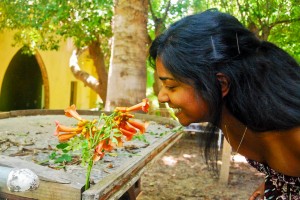Thesis Showcase: Hirumi Nanayakkara Powers Your Phone With Bacteria
In this series, second-year D&T MFA students explain what they are doing with their thesis projects, where they apply what they’ve been learning toward their personal interests. Below, Hirumi Nanayakkara explains why she’s excited about an interdisciplinary approach to combining dirt, beer, and iPhones. By Rachel Signer.
What’s the main idea of your project?
My thesis looks at renewable energy solutions through a multi-disciplinary approach. My case study uses bacterial reactions to harvest energy. There’s a certain strain of bacteria that, as it decomposes organic waste, releases electrons, and we can harvest that for our own power. The scientists who work on this now are using it for more industrial purposes, and I wanted to see how this could be integrated into urban systems, so everyday people can use this technology.
For a few months I was stuck on how to store the power–that’s the main issue that deters people from working on this. But I found an energy harvesting module that works really well, so I’m channeling power from the cell through the module into rechargeable batters. That’s powering my current prototype, an iPhone charger. I initially wanted to design for systems like Occupy when they were in the park and they needed power—so they wouldn’t have to hack into the power grid. I’m also interested in repurposing spaces like abandoned lots.
Another aspect of my thesis was about trying to forge connections between different industries—in biotech, people stay within their teams. I’ve been talking to biotech people as well as product designers. I’m an interaction designer myself. I’ve also been talking to architects about building hybrids of these systems, so that people can depend partly on natural things like bacteria to supply them energy. I’m imagining an idealistic, futuristic city, and people are really excited about it. It’s weird and cool to see a jar of dirt and bacteria, mixed with beer, and know that it’s providing power.
How have you funded it?
I applied to the Green Fund at The New School last semester—they gave out grants to sustainable design projects. I received $4000 and I used it for materials—electronics are expensive—wires, circuits and boards and so on. I wouldn’t have been able to do it without the funding. It allowed me to iterate with different kinds of microbial cells. My next phase is to build something that the New School can actually use to decrease its carbon footprint; that was part of the grant agreement. I’m working with a product designer to make a community charge station.
Do you have a business model for it?
I’m not so caught up in making money off it since so many people have been donating their knowledge to me, that I would feel strange about patenting this. I would love to have a start-up that is an incubator for this kind of thinking, because I’ve had a hard time finding the right kinds of experts, because we all have the same end goal—building a more sustainable city—but we have very specialized disciplines. If we shared a space and worked together—like how Steve Jobs put engineers and designers in the same room—we could work much more quickly. So, for my thesis I’m writing grant proposals for this kind of incubator.
What has been the most challenging aspect of your project?
Finding those collaborations. Maybe half the people who helped me don’t live in New York. I found them through Google and communicated through Skype and e-mail. But they were really generous with their time and willing to talk with me and troubleshoot. But it was a slow process.
What surprised you while you were working on it?
That it could work! It has been proven in some ways, but I didn’t know if people would actually be able to use this, and I was stuck on that energy harvesting problem for three months. I wanted to make something practical, something I could use or somebody off the street.
How has this program been supportive to your project?
Primarily the funding, also my advisors have been amazing, putting me in touch with people who they thought could help if they couldn’t provide solutions.


